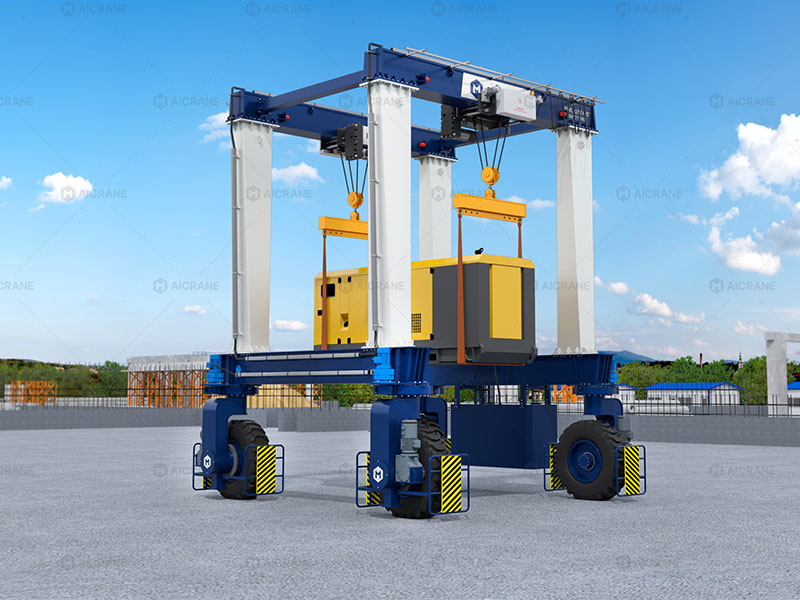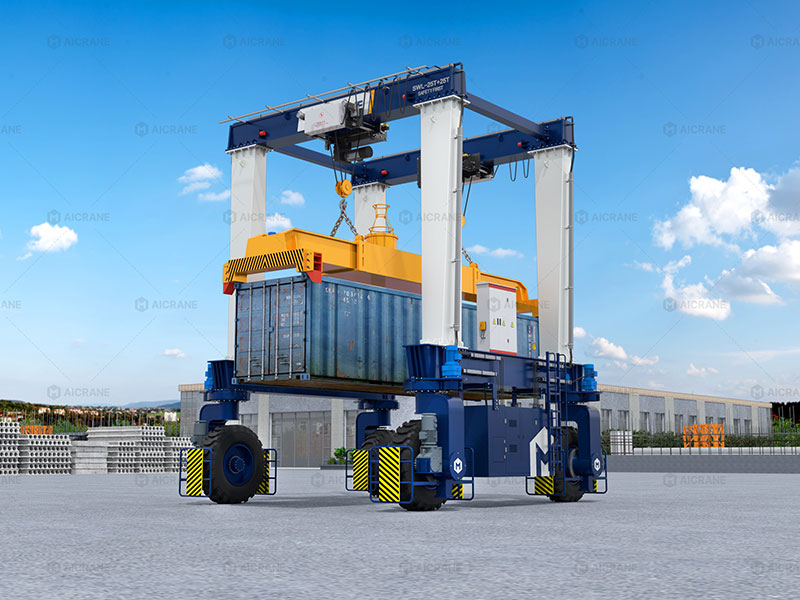In the world of material handling, efficiency, safety, and flexibility are essential. When it comes to heavy-duty lifting operations, Rubber Tyred Gantry (RTG) cranes stand out due to their versatility and mobility. These cranes are commonly used in ports, container yards, and industrial sites for tasks such as moving shipping containers, handling heavy loads, and performing high-precision lifts. One of the critical aspects of maximizing the performance of an RTG crane is the lifting attachment.
A lifting attachment is an accessory or tool designed to connect the crane’s hook to the load. It plays a significant role in improving the crane’s functionality, especially in applications requiring specialized handling. Custom lifting attachments are designed to meet specific operational requirements, allowing rubber tyre gantry cranes to tackle a variety of lifting tasks with precision and efficiency. This article explores the importance of custom lifting attachments for RTG cranes, the types available, and the key benefits they offer.

Why Custom Lifting Attachments Are Essential for RTG Cranes
Rubber Tyred Gantry cranes are commonly used in dynamic environments such as container terminals, warehouses, construction sites, and shipyards, where operations are often complex and diverse. In such environments, off-the-shelf lifting solutions may not always be sufficient to meet the specific needs of a project. Custom lifting attachments help to bridge this gap by providing the following key benefits:
1. Optimized Efficiency
Custom attachments are tailored to match the exact lifting requirements of a given task, which significantly enhances the overall efficiency of operations. Whether the job involves lifting oversized cargo, stacking containers, or moving irregularly shaped materials, a customized attachment ensures that the crane operates at its full potential, reducing downtime and improving productivity.
2. Enhanced Safety
Safety is a paramount concern when operating heavy machinery like RTG cranes. Custom lifting attachments allow for a more secure and stable connection between the load and the movable gantry crane, preventing accidents caused by improper or inadequate lifting devices. By using attachments that are designed specifically for the load type, the risk of load slippage or crane imbalance is minimized.
3. Increased Load Capacity
RTG cranes are designed to handle heavy loads, but the addition of a custom lifting attachment can further enhance their lifting capacity. By optimizing the geometry and design of the attachment, it is possible to increase the crane’s ability to handle particularly challenging or heavier loads, which is essential in industries that deal with large-scale and cumbersome materials.
4. Versatility in Applications
A single RTG crane can serve a variety of functions, depending on the attachments it uses. Custom lifting attachments enable the crane to perform tasks across multiple industries, such as the marine, construction, logistics, and manufacturing sectors. This versatility ensures that RTGs remain adaptable, enabling them to handle a wide range of lifting operations.

Types of Custom Lifting Attachments for RTG Cranes
The diverse applications of RTG cranes require a variety of lifting attachments, each designed to perform specific tasks. Below are some of the most commonly used custom lifting attachments for RTG cranes:
1. Container Lifting Spreader Beams
One of the most common lifting attachments for RTG cranes is the container lifting spreader beam. These attachments are designed to lift shipping containers efficiently and safely. Custom spreaders can be designed to accommodate different container sizes, such as 20-foot, 40-foot, and 45-foot containers, ensuring that the container handling gantry crane can operate in any container terminal or port environment.
Spreader beams come in different configurations, including two-point, four-point, and adjustable spreaders. Custom spreaders are designed to fit specific container types, ensuring a stable lift and reducing the risk of container damage during handling.
2. Grab Buckets
In industries where loose materials like coal, gravel, or scrap metal need to be moved, grab buckets are ideal for RTG cranes. These attachments can be custom-designed to accommodate different materials, from bulk solids to irregularly shaped objects. The design of the grab bucket can vary based on the size of the load, its weight, and the required grip.
For instance, in a port or shipyard setting, grab buckets can be customized to handle large quantities of bulk cargo, while in the construction industry, they can be modified to lift heavy concrete or construction materials. Custom grab buckets ensure that the RTG crane can perform these specialized lifting operations without risk of spillage or material damage.
3. Magnetic Lifting Attachments
For lifting ferrous materials like steel coils, beams, and scrap metal, magnetic lifting attachments are an excellent solution. These attachments use powerful electromagnets or permanent magnets to secure the load during transport. Custom magnetic attachments can be tailored to meet the lifting capacity requirements of the RTG crane while ensuring safe and efficient handling of metallic objects.
Magnetic lifters are especially useful in steel mills, scrap yards, and construction sites where metal objects are frequently moved. A custom magnetic lifting system ensures that the RTG crane can handle materials of varying sizes and shapes, maximizing its utility in different industries.
4. Forks and Pallet Lifting Attachments
In warehouses and distribution centers, fork attachments are often used for moving pallets and stacked materials. Custom fork attachments for RTG cranes can be designed to handle a range of materials, from large boxes and equipment to smaller, more delicate items. These attachments ensure that materials are lifted and transported safely, reducing the risk of damage during movement.
Custom fork lifts can be built with adjustable widths, length adjustments, and various weight capacities to suit different operational needs. Whether it’s a high-density storage system or a facility dealing with large-scale shipments, custom fork attachments increase the versatility of RTG warehouse gantry cranes in various storage and logistics environments.
5. Specialized Hooks and Slings
In addition to the more commonly used attachments, RTG cranes may also benefit from specialized hooks and slings for specific loads. Custom lifting slings can be designed for lifting tall, awkwardly shaped, or delicate items that require a more secure connection to the crane. These attachments are particularly useful for handling machinery, structural components, or oversized items that cannot be lifted with conventional hooks.
Specialized lifting hooks and slings are engineered with the right material and strength characteristics to match the load’s shape, size, and weight, enhancing the stability and safety of the lift.
Factors to Consider When Designing Custom Lifting Attachments
When designing custom lifting attachments for RTG cranes, several factors must be taken into account to ensure the solution is effective, safe, and efficient:
1. Load Characteristics
The weight, shape, and fragility of the load are critical factors when designing a custom lifting attachment. For example, heavy, dense materials like steel coils may require a completely different attachment than lighter, fragile items like electronics or glass panels. Custom attachments must be designed with these load characteristics in mind to prevent damage and ensure a secure lift.
2. Safety Regulations
Safety is always a priority when designing lifting equipment. Custom attachments must meet both international and local safety standards to ensure they are fit for use. This includes considerations for load limits, failure prevention mechanisms, and appropriate locking systems to ensure that the load remains securely attached throughout the lift.
3. Compatibility with RTG Crane Specifications
A custom lifting attachment must be designed to be fully compatible with the RTG crane’s hook, lifting capacity, and operational parameters. This ensures that the crane can effectively handle the load without exceeding its limits, maintaining the crane’s overall performance and safety.
4. Environmental Conditions
The environmental conditions in which the RTG crane operates also influence the design of custom lifting attachments. If the crane is used in extreme weather conditions, such as in coastal ports where exposure to saltwater can cause corrosion, the attachment must be made of durable, corrosion-resistant materials.
Conclusion
Custom lifting attachments are a crucial component in maximizing the versatility and efficiency of Rubber Tyred Gantry cranes. Whether for lifting containers, bulk materials, steel products, or oversized machinery, custom solutions allow RTG cranes to handle a wide range of lifting tasks with enhanced safety, performance, and productivity. By tailoring lifting attachments to specific operational needs, businesses can optimize their equipment, reduce downtime, and ensure safer and more reliable lifting operations. As industries continue to evolve, the demand for custom lifting solutions will only grow, making these attachments an indispensable part of modern material handling.
